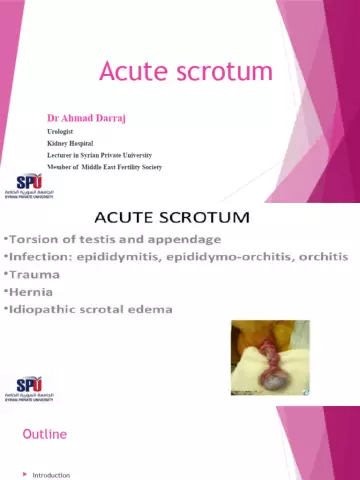- Author Curtis Blomfield [email protected].
- Public 2023-12-16 20:44.
- Last modified 2025-01-23 17:01.
Eyes are an extremely important sense organ, because a person receives most of the information from the outside world through vision. This organ is located in the bone orbit, soft tissues are located around it. The conjunctiva and eyelids play a protective role and cover the front of the eye. The lacrimal apparatus of the eye includes the lacrimal gland and the pathways along which the tear passes.
The fluid leaves the gland, and then moves to the conjunctiva (which is located at the outer corner of the eye) and moisturizes the cornea of the eyeball, thereby saving it from drying out. Then the tear goes to the lacrimal lake, which is located at the inner corner of the eye, it consists of special nipples and the lacrimal opening. The upper and lower lacrimal ducts form the lacrimal sac, which passes into the nasolacrimal duct and opens into the nasal cavity. This is how the tear is discharged into the nasal cavity from the eye. Thus, the structure of the lacrimal apparatus of the eye can be considered quite complex and unique.
Destiny of tears
Tear -it is a slightly alkaline liquid that regularly bathes the surface of the eye and is of great importance in the function of the lacrimal apparatus of the eye. Transparency and ideal smoothness of the cornea is ensured by this liquid, which covers its entire surface, protects it and improves the visual properties of the organ. S alts, lipid and protein particles, which are dissolved in tears, play an important trophic role and nourish the cornea. Also, the tear consists of antibacterial substances that prevent infections and bacteria from entering the eyes. Moreover, it has mechanical functions: it removes all foreign bodies that get into the eyes, washing them off the surface of the apple.

Diseases of the lacrimal apparatus of the eye
Symptoms indicating damage to the eye organ can be very different. They are manifested by a sensation of a foreign body, sand in the eyes, as well as burning, dryness, or, on the contrary, the outflow of lacrimal fluid may be disturbed and excessive tearing will appear. A large secretion may take place at the lacrimal opening, in the nasal cavity, or at the border of the lower eyelid. In this case, inflammation of the lacrimal sac occurs, resulting in swelling, swelling and redness of the corners of the eyes. This usually happens when the gland is damaged.
Diagnosis of disease
For the diagnosis of diseases, a full-time examination of a specialist is necessary. On palpation of the lacrimal sac, as a rule, there are painful sensations. It is possible to examine the required part of the lacrimal gland with a slit lamp, for this, the upper eyelid should be turned out. Estimatethe condition of the lacrimal openings, as well as the level of hydration of the conjunctiva and cornea will help microscopy of the eye. As a result of disturbances in the work of the lacrimal glands, tissue cells begin to die, which leads to atrophy of the organ.

Required examination
X-ray examination using contrast dacryocystography assesses the level of fluid permeability through the lacrimal ducts and shows the degree of destructive process in the lacrimal glands. To understand how well the lacrimal fluid passes, you should flush the paths. Ideally, water that is injected into the punctum ends up in the nasal cavity and then into the mouth. To accurately determine the patency, a test with fluorescein is used. The Schirmer test is done to evaluate the rate of tear advancement. They take special test strips, put them under the lower eyelid, and then they diagnose. The speed with which they get wet allows you to understand the state of the lacrimal gland. Secretion in the lacrimal apparatus of the eye is impaired if the wetting rate of the strip is less than 1 mm per minute.

Treatment
When violations are detected, the therapy of drugs is prescribed, which in their composition are analogues of the lacrimal fluid. Then doctors identify and eliminate the cause of the pathology at an early stage. In order to slow down the lacrimal fluid or slow down its movement, the lacrimal openings are blocked by special plugs. If inflammatory diseases become the cause of the pathology, a course of antibacteri altherapy, or surgery may be required, and then postoperative restoration of the lacrimal ducts and their outflow. In some cases, drug treatment becomes useless, or the disease becomes chronic. In such a situation, endoscopy is performed. This happens through incisions that are made between the nasal cavity and the lacrimal sac. The incisions are made from the side of the nasal mucosa, as a result of which the free outflow of tears is restored.

The lacrimal apparatus of the eye plays a huge role in the optical function of the human body, the violation of its functions leads to many problems. You should take care of your he alth, undergo examinations in a timely manner and adhere to preventive recommendations that will help prevent possible pathologies. By seeking help from a specialist early on, you can save your vision and prevent a recurrence.






